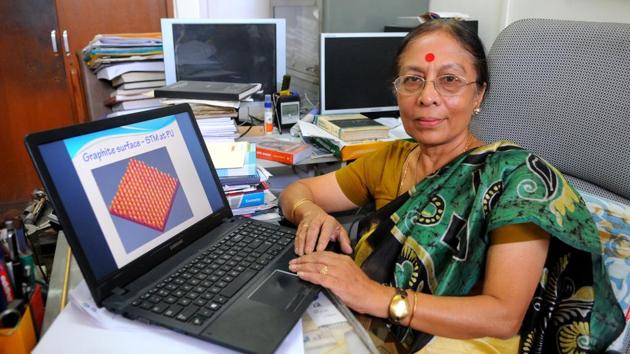This woman researcher from PU brought culprits to book by using physics
Keya Dharamvir, 68, professor (retd) from physics department of Panjab University prefers to not focus on the larger picture and instead remains fascinated by particles of submicroscopic size and their various uses.
Though she has research interests in a wide variety of areas and a passion for computational and experimental science, 68-year-old Keya Dharamvir, superannuated faculty member of the physics department in Panjab University, remains fascinated by condensed matter physics that deals with the macroscopic and microscopic physical properties of matter; and nanomaterials that contain nanoparticles of submicroscopic size.

An IIT Kanpur alumna and postdoctoral fellow from the Imperial College of Science and Technology in London, Dharamvir’s PhD and postdoctoral thesis (on mixed valence systems) was considered a pioneering study that’s still quoted with over 400 citations.
Currently a guide to a PhD scholar from the Indian Institute of Science Education and Research, Mohali, and working with the botany and chemical engineering department at PU to study the effect of nanoparticles on seeds, Dharamvir says “all kinds of nanoparticles can be used for field applications on seeds as they have low levels of toxicity.”
A coordinator for the nanoscience and nanotechnology programme run by the Centre for Nano Science and Nano Technology, University Institute for Emerging Areas in Science and Technology (CEAST), Mohali, Dharamvir says research on nanoparticles started in the 1980s and she helped design and launch the programme at Panjab University.
“We began with looking at Carbon-60, studied the properties of carbon and produced carbon nanotubes,” which are cylindrical molecules comprising rolled-up sheets of singlelayer carbon atoms (graphene). These are known to have perfect conductivity.
Gathering and collating data, analysing it, reading up on the latest in one’s field are all a part of the theoretical nature of research, but a large amount of time is also spent in labs doing experiments. “Every researcher spends the day teaching students and the evenings in labs, that’s how my days go by.”
Crediting her school for her interest in science, she says she was taught by “fantastic teachers who cultivated my interest in mathematics and science.”
Born and brought up in Allahabad, Dharamvir is a Bengali and belongs to a family that has always been involved with the sciences. Her granduncle RK Sood was a physicist who collaborated with CV Raman on research projects and father a civil engineer with a degree from IIT Roorkee. Her husband has degrees from IIT Kharagpur and Kanpur. The couple’s two sons are also IIT graduates.
With three research projects funded by the Indian government’s Department of Science and Technology and Nuclear Science Centre, Delhi, to her credit, Dharamvir also proposed and prepared a project that led to Panjab University getting shortlisted as a Centre for Potential in Nano Sciences by the UGC and fetched a ₹1.2 crore grant in 2011.
Married when she was pursuing her PhD in 1976, this scientist says her first son was five years old when she went to London in 1984 for her post-doctoral fellowship. “Everything is manageable,” she says.
She believes scientific research has its uses, including criminal investigation. Referring to a traffic fatality in 1997, she said, “A lawyer walked into my office and told me that his daughter had been run over by a car and he needed to prove in court that it was intentionally done. Now we have simulations for such cases but back then I had to do a methodical analysis of the data available to prove the case,” she says.
After she helped bring the culprits to book, “a day after the judgment, when I went to class, I received a standing ovation from my classmates and it was a good feeling,” she says.
Talking about the highs and lows of her career, Dharamvir, who started her career by teaching in government colleges of Haryana, says, “I have felt good completing each project.”
The Dharamvirs also run a Society for the Promotion of Science and Technology in India (SPSTI), which aims to generate interest in science among people, especially students, with its programmes.
“Some of the regular activities by SPSTI are mobile science laboratories in schools, summer school classes in mathematics and science for students of class 11 and 12 taken by IIT students,” she says.
Fond of reading, Dharamvir is currently catching up with Sapiens by Yuval Noah Harari and counts Chitra Banerjee Divakaruni’s Palace Of Illusions among her favourites.
She also likes meditating, yoga and watching soap operas.
“I have read all the Harry Potter books but I did not like the movies. A similar thing happened with Gone With The Wind. Movies just ruin your imagination,” she says.



